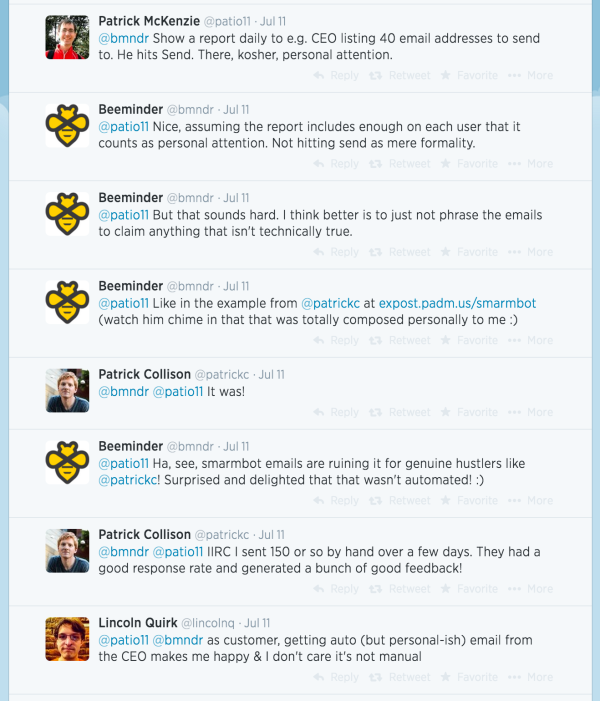
In which the CEO of Beeminder quibbles with Patrick McKenzie, aka patio11, about what we call smarmbot emails, while noting how much we adore Patrick McKenzie (else we wouldn’t bother quibbling with him).
Humans of the internet! This post isn’t really for you, but if you’re curious what we’re talking about, lifecycle emails are what companies are doing when they automatically send you a series of emails like “thanks for signing up for our thing!”, and “you don’t seem to have actually used our thing yet; can we help with that?”, or “now that you’ve done X, you should maybe do Y!”, and so on. There’s a particular way those can be, well, smarmy, and we want to convince our fellow startups not to do that thing.
Fellow startups! I think you should follow all of Patrick McKenzie’s brilliant recommendations for lifecycle email copywriting, except for this one:
“Hi $NAME, I saw that you signed up for mycompany.com a few days ago.”
Why not? Because it has the intent to deceive the recipient — should they happen to be sufficiently naive — that there’s a human taking a personal interest in them.
Our compromise has been to add “PS: this is obviously automated but you can reply and we’ll see it”. (You do want to emphasize that the user can reply like normal even though it’s an automated email.) Or just saying “we” instead of “I” can go a long way towards de-smarming. Then it’s like “we, our whole company, including the programs that send these emails”. It is a subtle difference, but feels much more genuine to me, and is less likely to trigger my disgust reaction. An email from Patrick about how he noticed something about you is, well, false.
I can imagine a counterargument along the lines of the email retroactively becoming true for the subset of customers who actually reply to it. But that only ensures you won’t get caught making a false statement.
When I broached this with patio11 on the Twitters, he proposed a compromise involving semi-automation which I’m semi-OK with, depending on how it’s done. And Lincoln Quirk, a known Beeminder sympathizer, even chimed in on patio11’s side, saying email from the CEO makes him happy and he doesn’t care if it’s automated.

So despite there being some evidence against the humans of the internet actually caring about this kind of thing, I think there’s a deeper issue at stake. These smarmbot emails may be ruining it for the hardworking non-robots of the internet. Consider this email from Stripe’s Patrick Collison (@patrickc), which I assumed was an automated email, and even went so far as to hold up more than once as an example of staying (barely) on the good side of the smarmbot line since it never makes a claim like “I (personally) noticed…”:
Hey,
I’m one of the cofounders of Stripe. Since you’ve been using us for payments for a while, I figured I should briefly check in to see how things are going and to see if there are things we could be doing better. Is there anything we should improve, or are there things we should build that’d make things easier for you? (No need to respond if nothing jumps to mind or if you’re too busy.)
Feel free to ping me with questions, too, either now or in the future.
Cheers,
Patrick
P.S. Also, we’d love to send you a Stripe t-shirt if you’d like one! (Or several.) Just let me know.
After I pointed patio11 to this shining example of sufficiently non-misleading automated emails, patrickc chimed in to tell us all that it was in fact sent personally by him.
Anyway, bots are to be expected. Moo.com did an adorable thing: they made up a persona — an explicit bot — to address the user in their order confirmation messages. They’re admitting it’s a bot, and giving it a moo-ish touch. People notice these things.
Illustration: Kelly Savage